After shooting the Leica M6 for just over a year, including a decent period with it as my only film camera, I thought it was time to put pen to paper; or fingers to keys, as the case may be. This is the first post of this style that I’ve written, so just bear with me as it evolves – part camera review, part musings on 35mm film photography, and part travel journal with some street photography taken in Japan…
I started shooting film in late 2002, during a trip to Europe, on a plastic fantastic Canon EOS300V and the “gem” that is the 28-90mm kit lens. Like all (most?) beginners, I lived on the green square for most of that trip. When I came back from 8 weeks overseas, I started working full time straight away and didn’t do much shooting for a while.
Around a year later I visited the USA just around the time that DSLRs were starting to take off. I ended up spending all of my meagre savings on a Canon 300D. It’s film sister camera was promptly shelved as I dived into the heady world of 6MP digital goodness…… fast forward, and I’m now shooting jobs (documentary / editorial / architecture / events / weddings) on the workhorse that is the 5Diii.
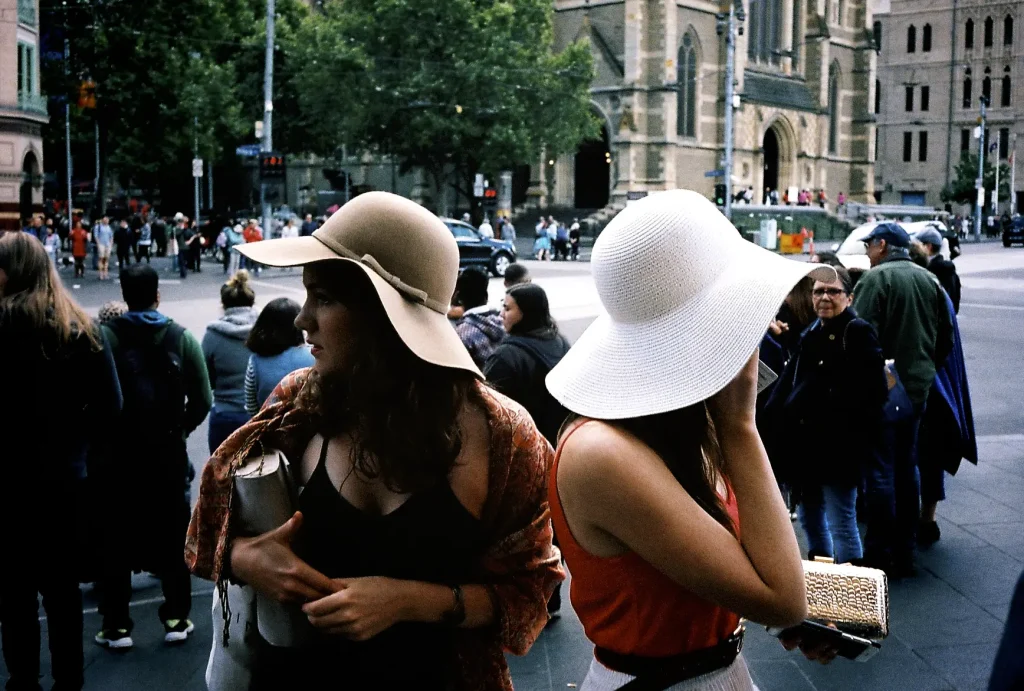
Aside from all of that I’ve always enjoyed shooting plenty of street photography. I’ve found it to be a really engaging and interesting way to spend time – there are so many different ways that people shoot on the street. This also means that it so varied and hard to define – how many posts have you read about people arguing about what can and what can’t be called street photography? Anyway, enough of an intro, you came here to read about the M6 right?
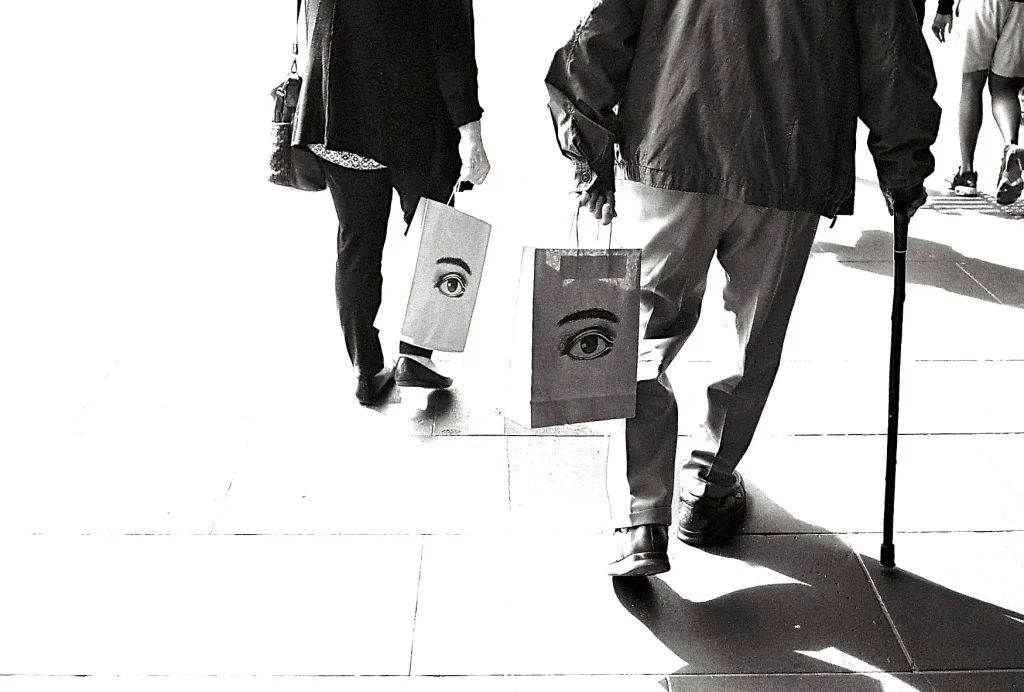
Early in February 2016 I was planning a trip to Tokyo. The aim in heading to Japan primarily was to go to Fukushima to shoot a photo documentary about the 5 year anniversary of the devastating earthquake, tsunami and nuclear disaster – which if you’re interested you can find on my blog here: F is For Fukushima.
Prior to heading up to Fukushima I squeezed in some time off in Tokyo. Having been there once before I knew how amazing it was…is…and wanted to spend some time dedicated to street photography for a few days. And what better place to do it than in among the overcrowded, hectic, jam-packed Japanese capital.
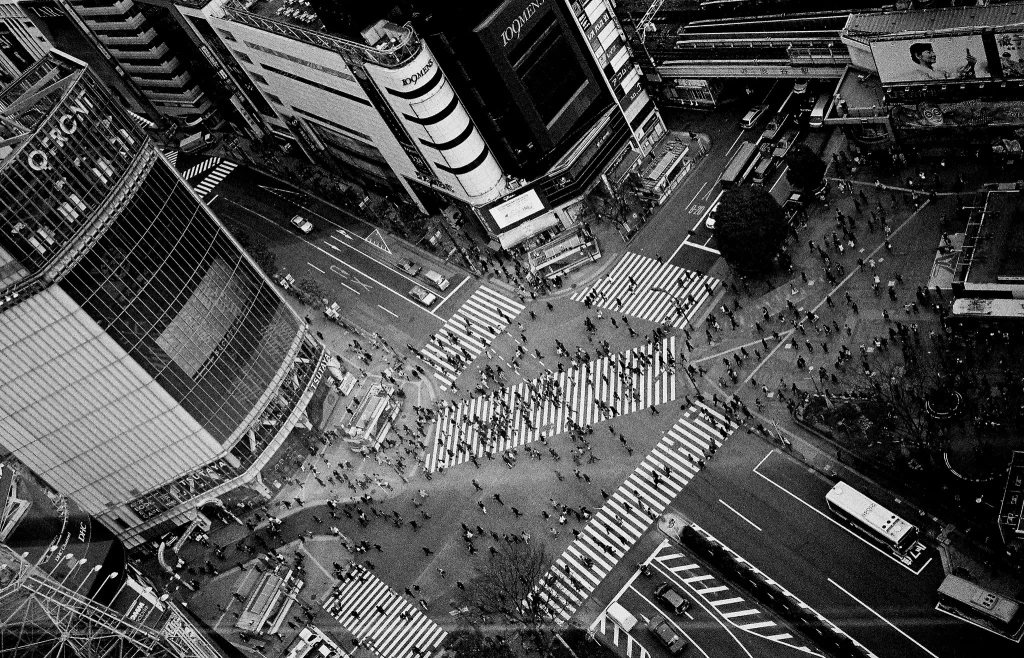
Choosing a Camera
Once the decision was made that I was going to Tokyo, I also felt compelled to start looking for a film camera. I’d been shooting street photography for a while, and knew I wanted … needed?… to try something different for a change. So I started asking the oracle of all things google on what were good options for shooting street on film.
35mm it was to be, as it needed to be small enough to not be too obtrusive – as my staple street shooter at the time was the (very capable) original X100. As mentioned earlier I wasn’t keen on an SLR style body – as I shoot enough of that on digital. There were a heap of options from cheap P&S to not so cheap: Oly XAs, Contax T2/T3, Ricoh GRs, Konica Hexar AF, Oly Mju & Trip 35s, Lecias plus a few other options from Oly, CaNikon, Yashica, Fuji etc. In the end, I was after something fully manual (focus and exposure), with an inbuilt meter, while interchangeable lenses would be great to give some more options down the track, rangefinders sounded interesting having had no experience, oh yeah and also (most importantly) it had to be all black….. 🙂
So after stumbling across a good looking used M6 classic in the window of a secondhand shop in Melbourne, it was love at first sight. After a bit of haggling to get as much of a discount as possible(!), the 1984 M6 headed out the door with me.
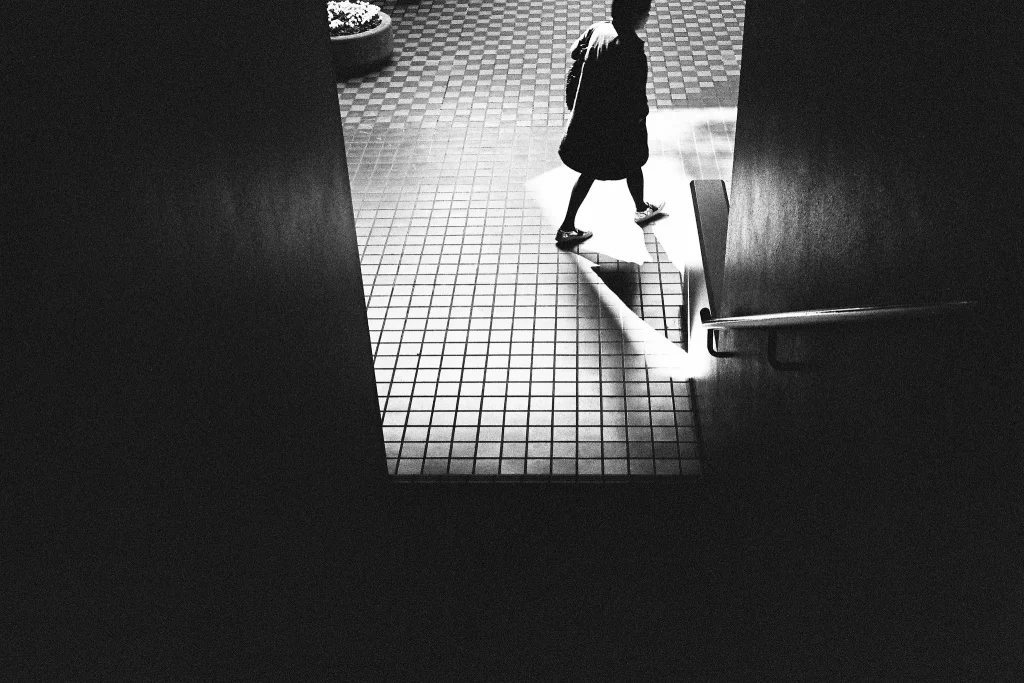
Next task was a lens. Time again to consult the smart little hamster in the googling wheel. Options at the cheaper end were generally Russian, mid-priced (and nicely compact) Voigtlander Cosina (VC), a step up to Zeiss or just go and sell one of your kidneys (again) Leica. The reviews of the VC (or if you want the full mouthful, the: Voigtlander Wide Angle Color-Skopar Pan 35mm f/2.5-M PII) seemed generally positive, glowing on some. So the performance seemed to be there. Secondly being the 2.5 option it was compact – another box ticked. Lastly, and most importantly, you could get it in black. Hook, line and sinker. Sold.
Shooting the Leica M6 on the Street
The experience of using the M6 to shoot in the street really is a joy. Loading it, winding it on, focusing with the patch, and using the meter – which is accurate and very simple. Also the fact that (aside from the meter) it is all manual – and can be used at all shutter speeds without a battery if needs be. I found the process of rangefinder focusing quite addictive and very enjoyable.
The fact that the camera is (relatively) small compared to SLRs, and the shutter really is very unobtrusive is great. Not so quiet however that there isn’t an audible and satisfying click when the camera is fired. Depending on how you usually shoot, you really can get very close to people and capture what is going on without people changing their behaviour – which for me is a very important aspect in how I like to shoot on the street. The shots in the next set were all taken after returning from Japan.
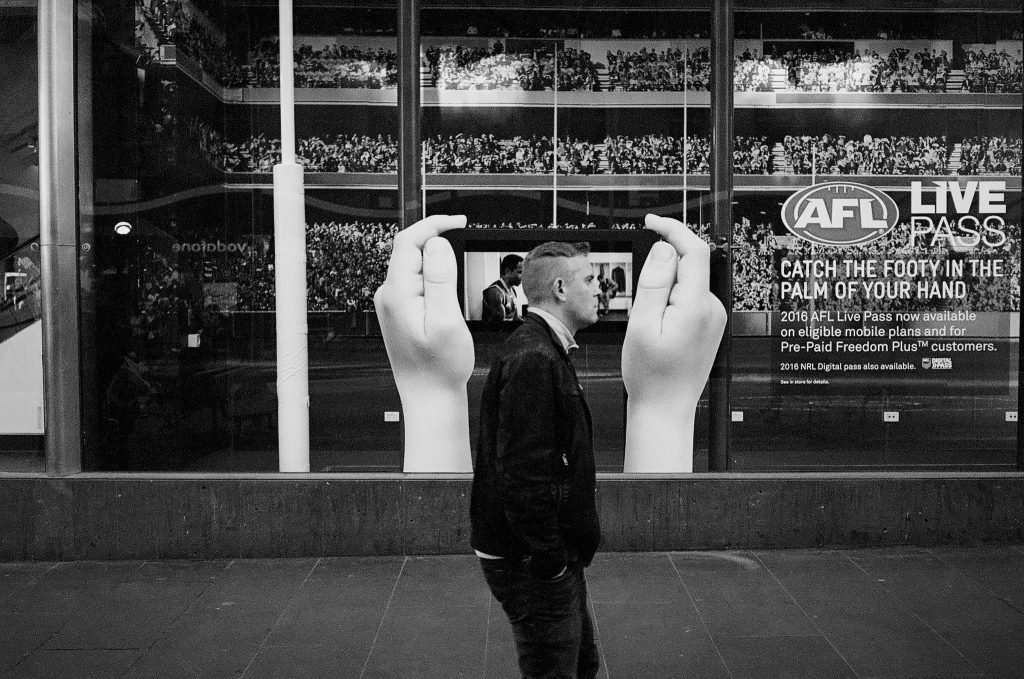
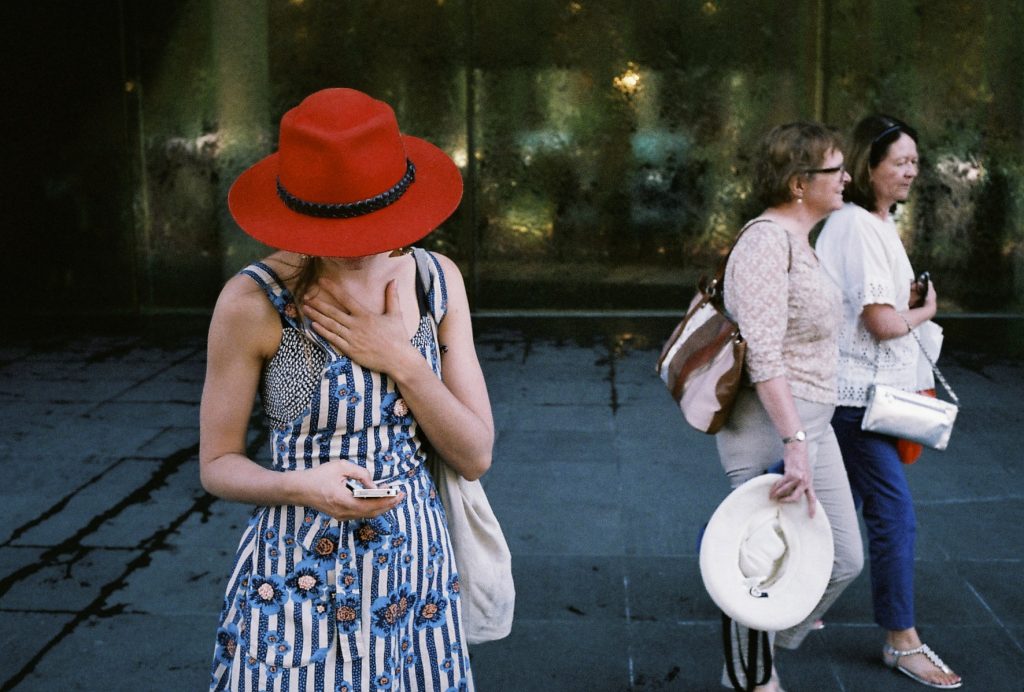
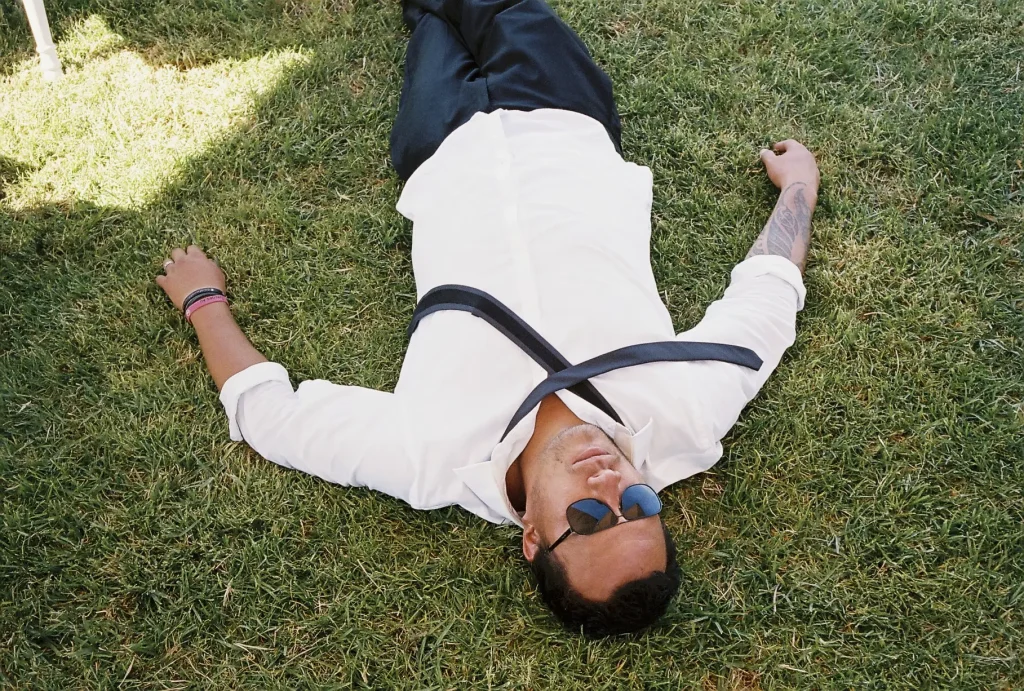
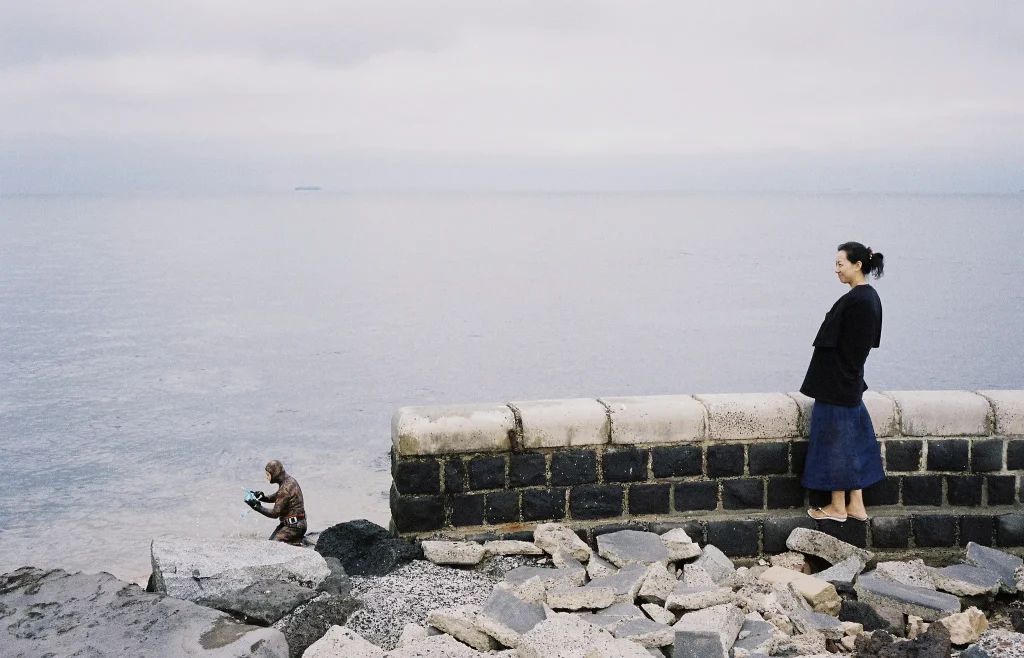

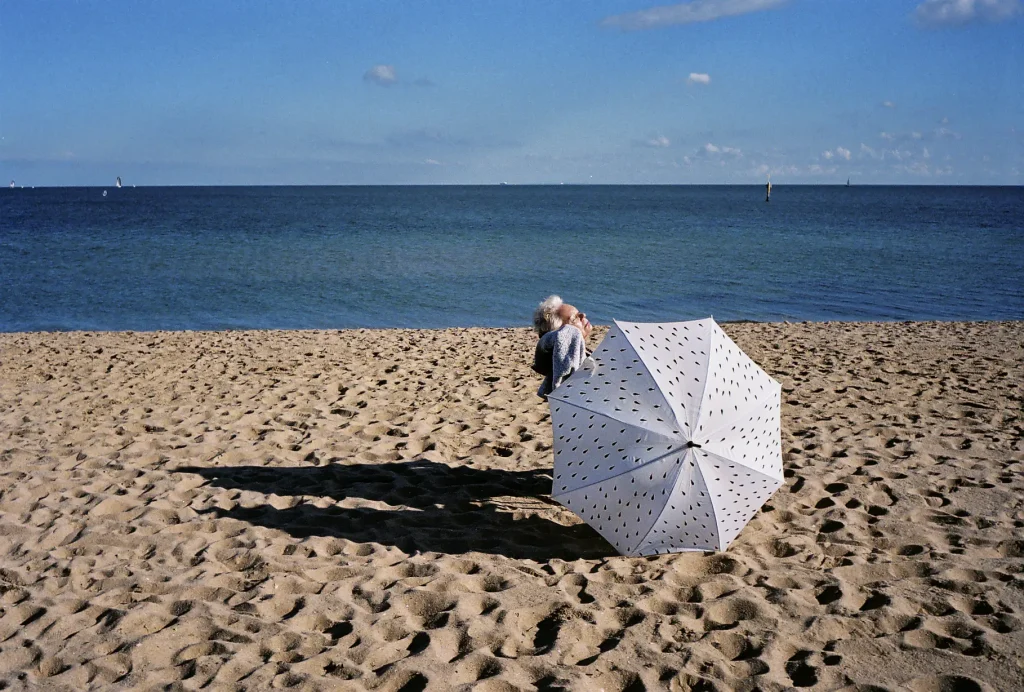
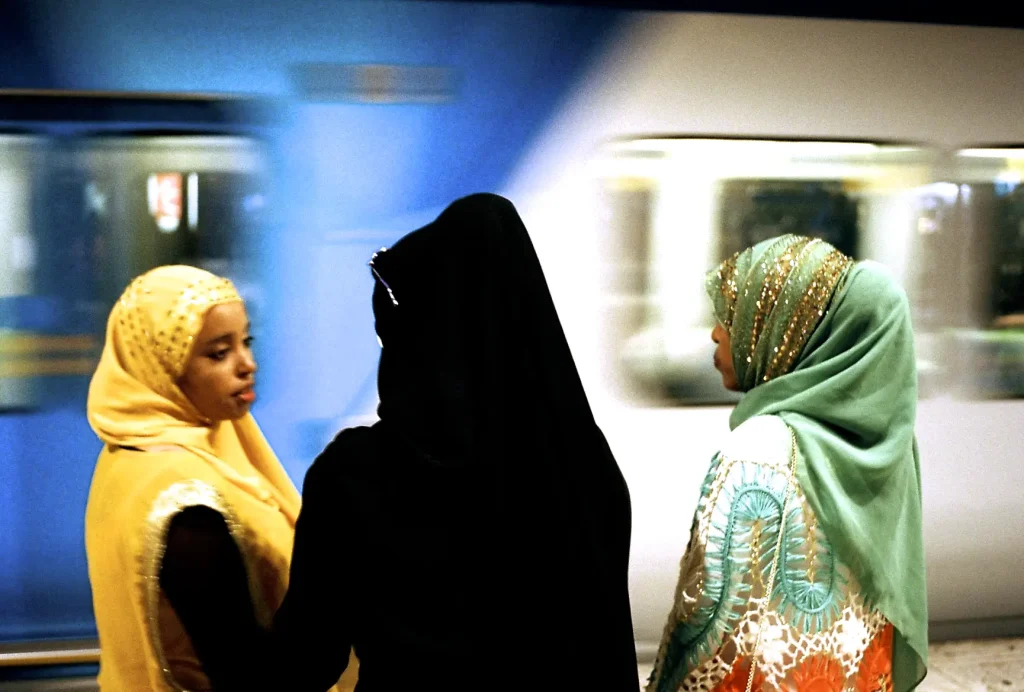
Sorted. I was able to squeeze in 3 test rolls on the new camera to get dev’d and scanned before taking off to Japan. The results were ok, and trusting the two red LED meter arrows seemed reliable, but getting used to having the single ISO of a film roll after the ease of digital took a little bit of time.
As a result, I left with a mixture of excitement and paranoia about not being able to look at the screen on the back of the camera in the street photographers paradise of Tokyo.
All in all, probably due to the mild paranoia mentioned above, across the 5 days I was in town, I ended up shooting 3 rolls of colour and 4 rolls of B&W and a fair bit of X100 (all the shots in this post are from the M6). And because I hadn’t shot film in many many years, instead of sticking to one type, like the kid in the candy store I shot a few different ones (Superia 400, Portra 400, Portra 800, XP2, Tmax & TriX). Maybe it is because there are so many people and so many colours and things going on in Tokyo – but I was happier with the B&W over the colour shots.
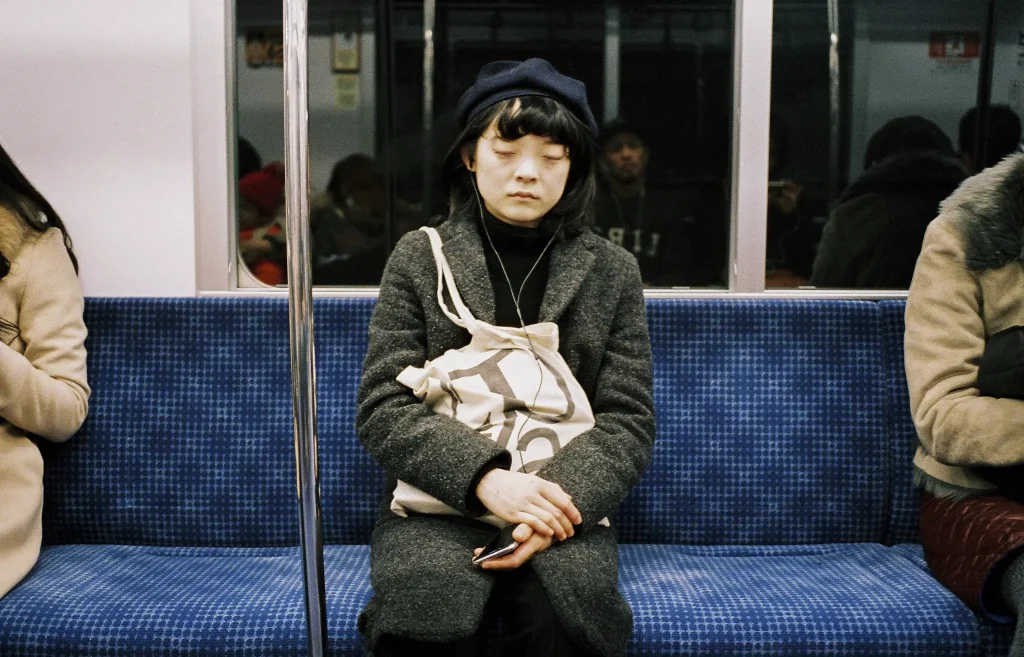
Shooting locations
Before I flew in I spent a bit (ok a lot) of time planning out where I wanted to go. I made myself up a google map with location pins (81 to be exact) of important stuff around the town. Forget asking people for directions, and don’t think you’ll be able to just look at street signs and numbers – it’s not gonna happen…. 😉
I wanted to go to the Tsukiji fish market to see the tuna auctions, and to get in there you need to get into the waiting room at some offensively obscene hour. It was also February, which meant it was properly cold. So, as a result, I decided to choose an Airbnb as close as possible to the market. I mean 3 mins walk close. It was great on the morning that I got up a 3.20 am to go the market, but not so great on the other days. Turns out there are little fish shops all around that area – who would have thought? They also get up with their forklifts and mini trucks every morning the markets are open at around 3 am. So like all Tokyo apartments this was *tiny*, but also had the bonus 3 am wake ups most days.
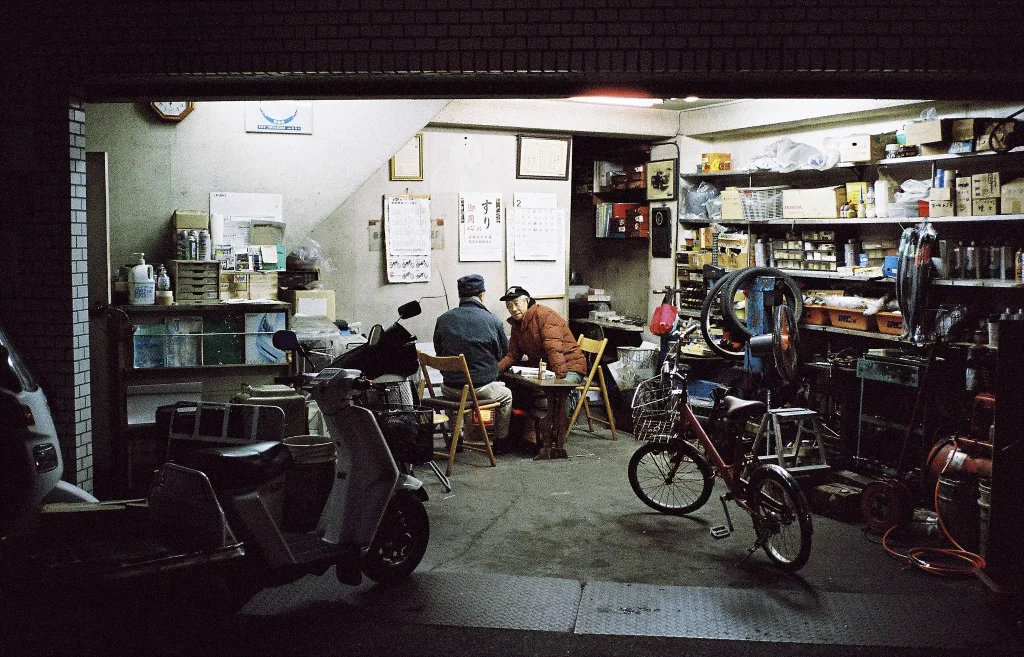
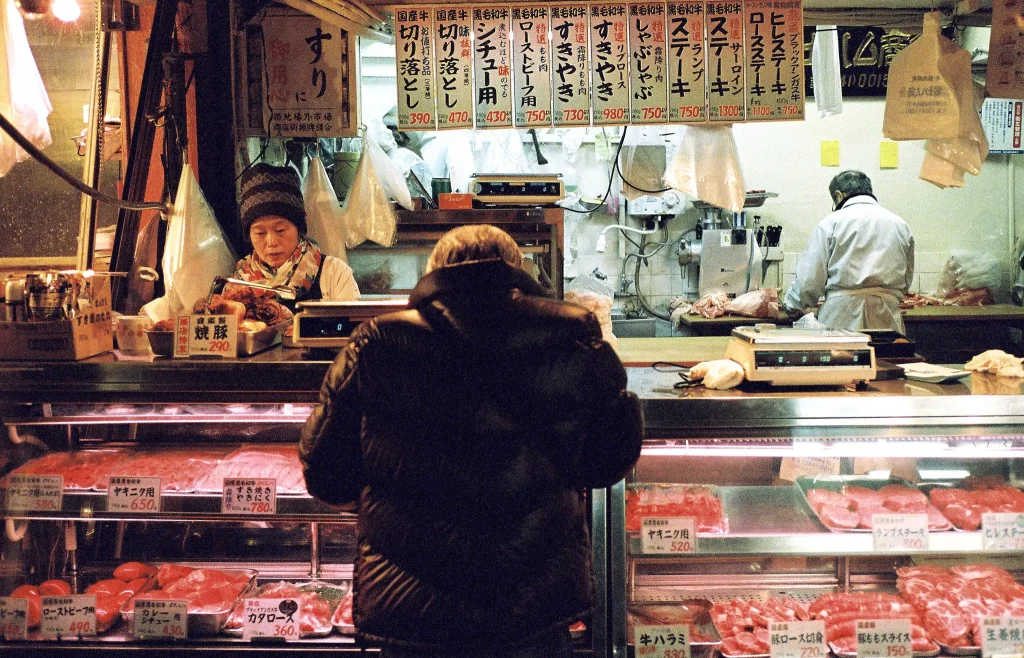
Ok, after getting the Tsukiji market done and dusted, there was a bucket list of places that I wanted to go. The vast majority of them would involve getting on the underground/subway. Probably the best system in the world. Much like pretty much everything in Japan, the trains just work properly – as they should. They run on time, they’re clean (but usually full of people), they’re fast and if you miss one, there is another one coming in about 6 mins – and it’ll be on time too. Once you’re on the train they are a joy (navigating inside some of the larger Tokyo train stations not so much). Oh, and if you like shooting street they’re also great, especially as pretty much no-one in Tokyo seems to care about cameras. Japan do make the odd camera or two….
It’s all B&W from here on in too…..
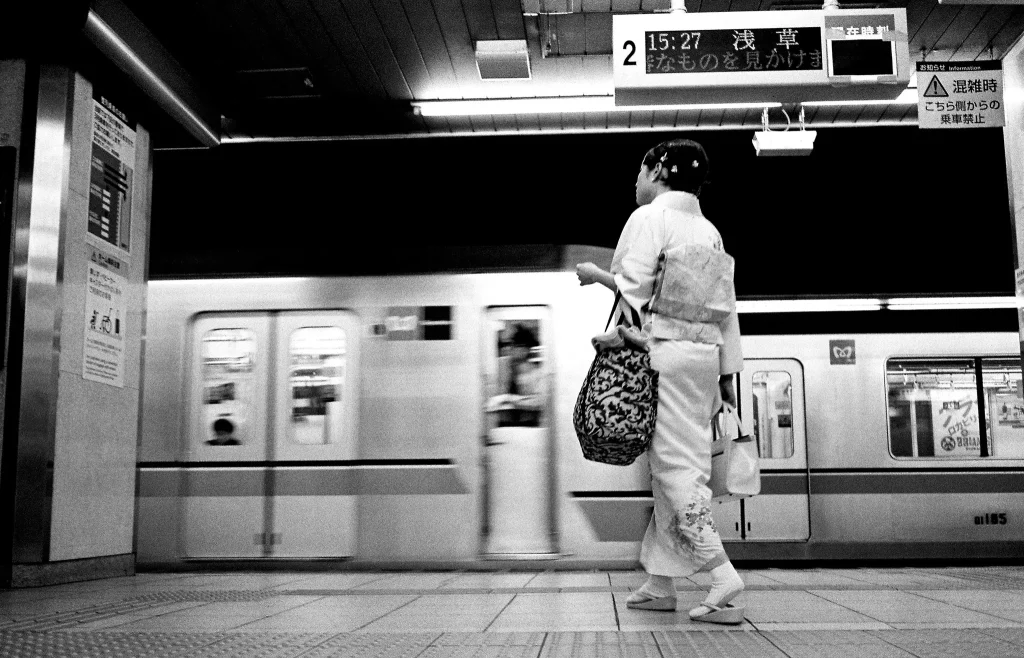
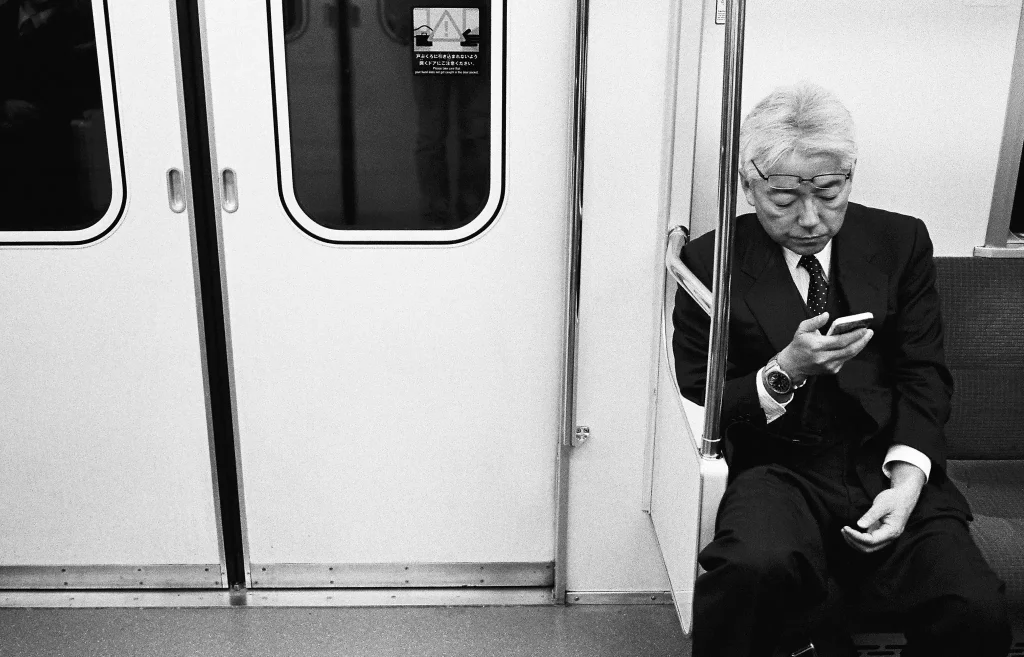
One of the reasons that I enjoyed shooting so much in B&W was that there are stunning patterns and geometry in so many different parts of the city that can be used as backdrops for the locals. You can guarantee if you sit and wait in a good spot for just a minute or two that you will find someone interesting walk straight into the frame… like shooting fish in a barrel.
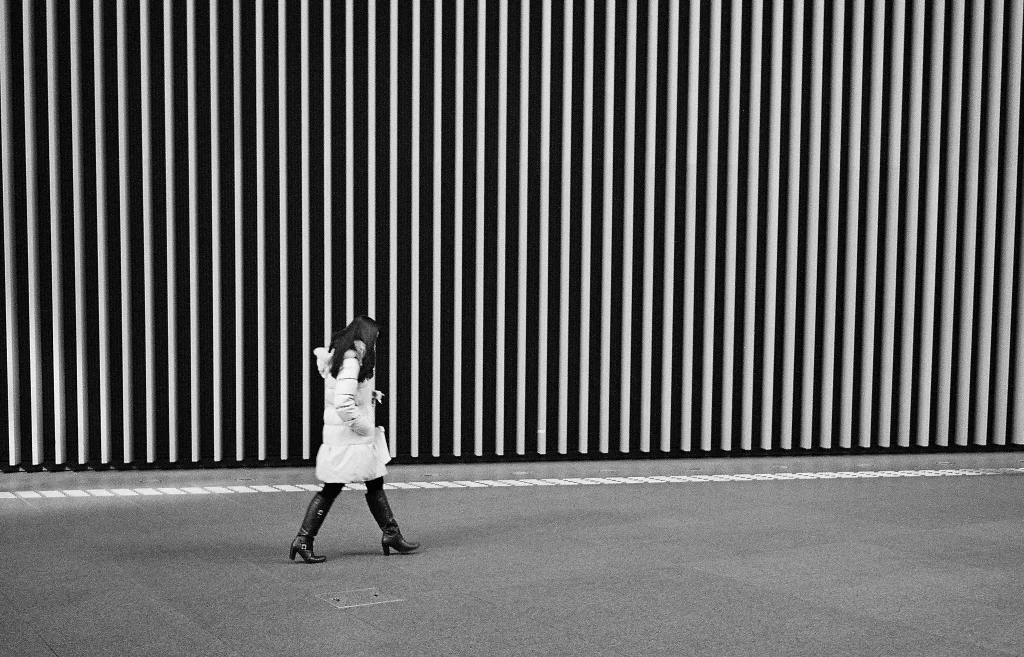
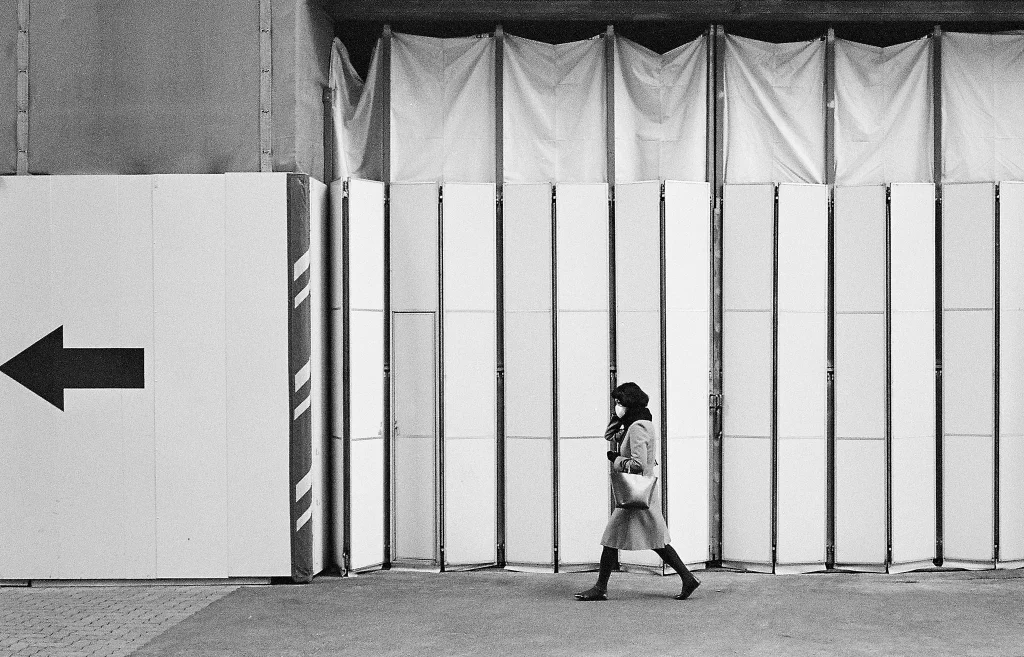
The buildings and skyscrapers in Tokyo also throw up some great architecture and lines that beg to be shot. The 3 shots below were all taken in Shinjuku, with the last two being the outside and then inside of the NS Building.
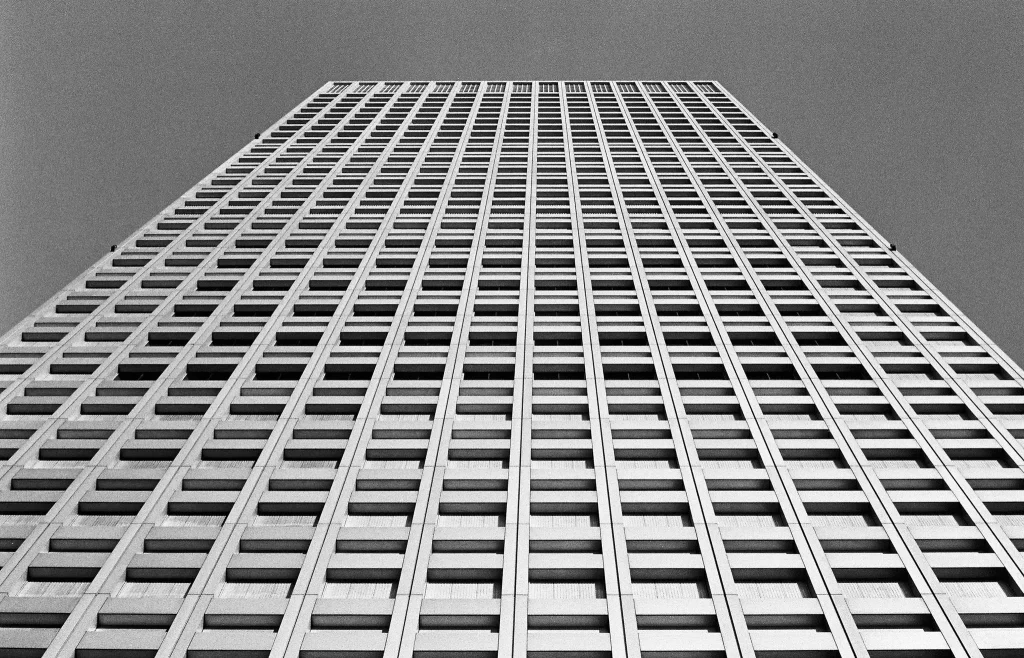
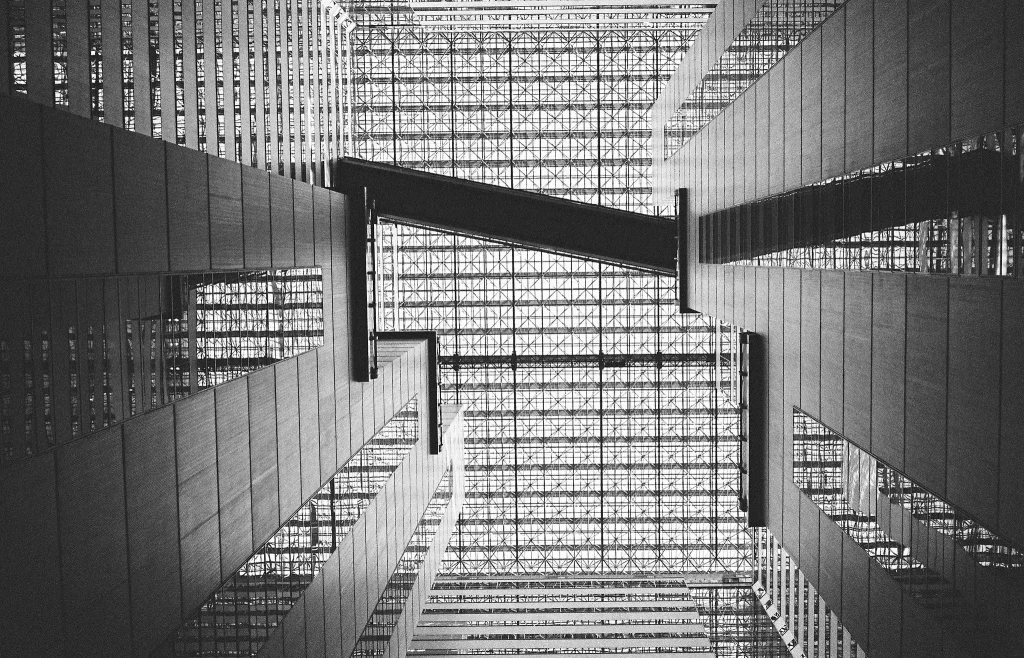
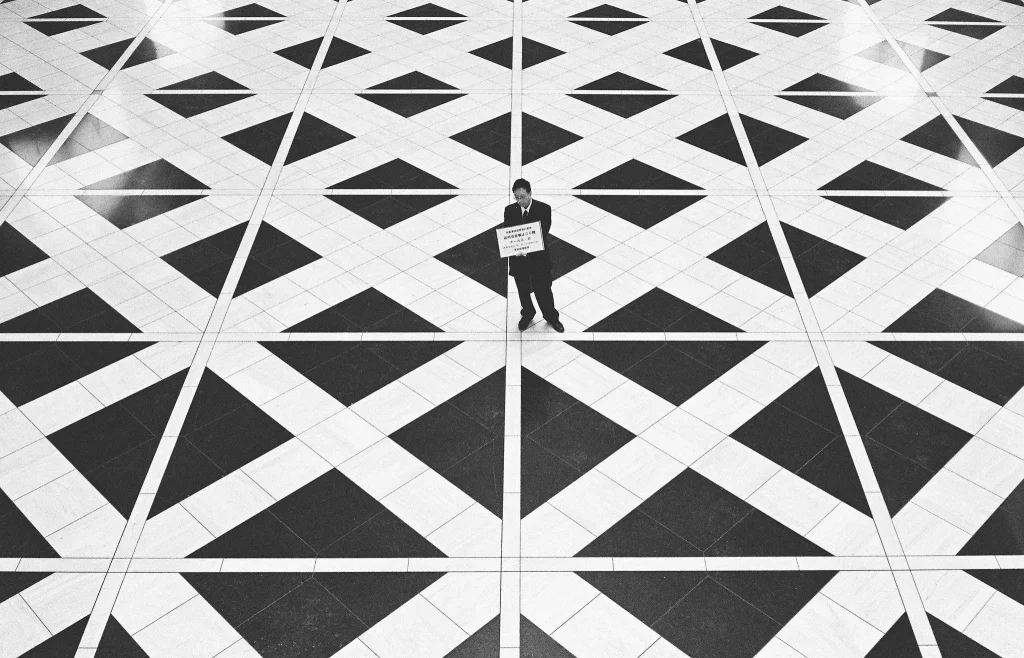
In terms of where I spent most of my time….it was probably Ginza. There are so many interesting spots there, and it was also not that far from Tsukiji where I stayed. So it made a logical start and end to the day. The other spots that I’d mapped down to visit were Harajuku, Shinjuku, Shibuya, Shimokitazawa (a bit of a hike, and probably not on everyone’s must see list of Tokyo spots), the platforms at the Tocho building & Bunkyo Civic Centre, Ebisu, ride the driverless monorail (Yurikamome line) and also visit a few of the dedicated photography bookstores in Jimbocho. I picked up a nice 2nd handbook by the well-known Japanese photographer Daido Moriyamama and a couple of other random books too.
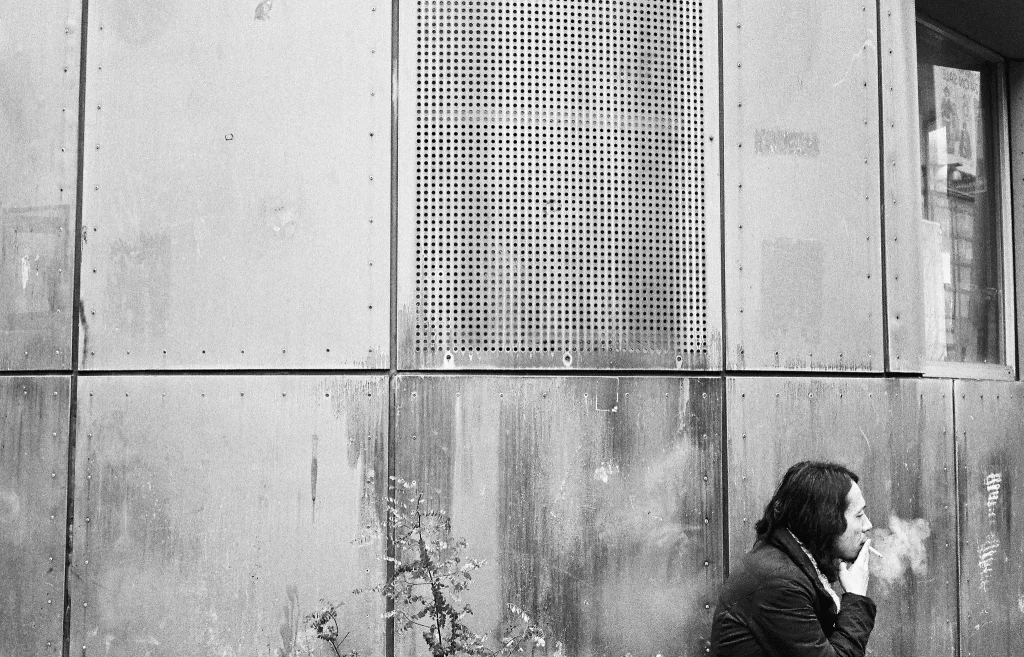
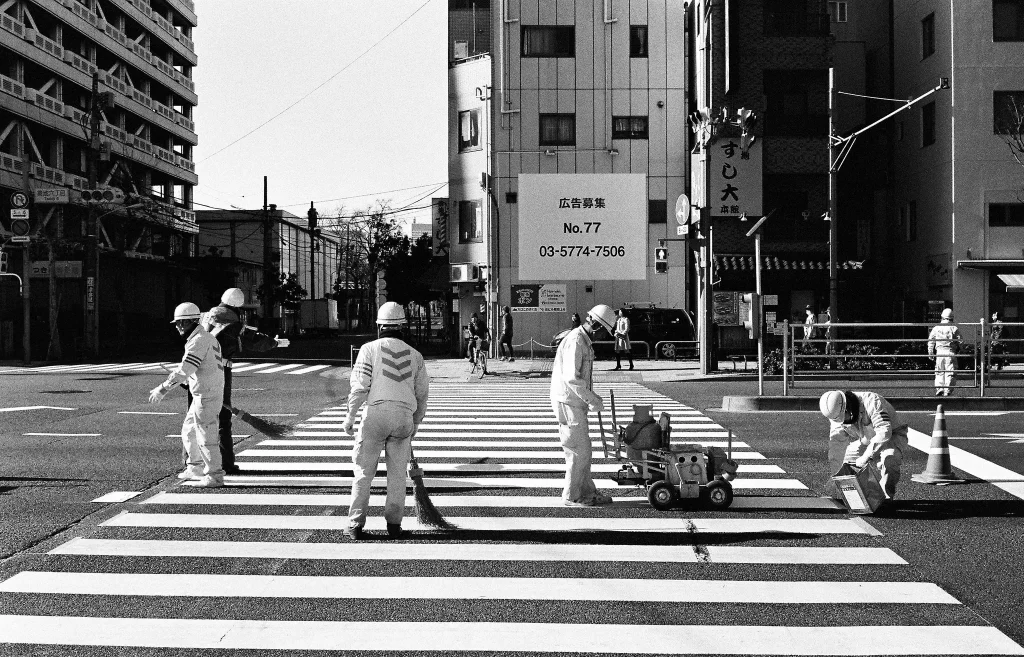
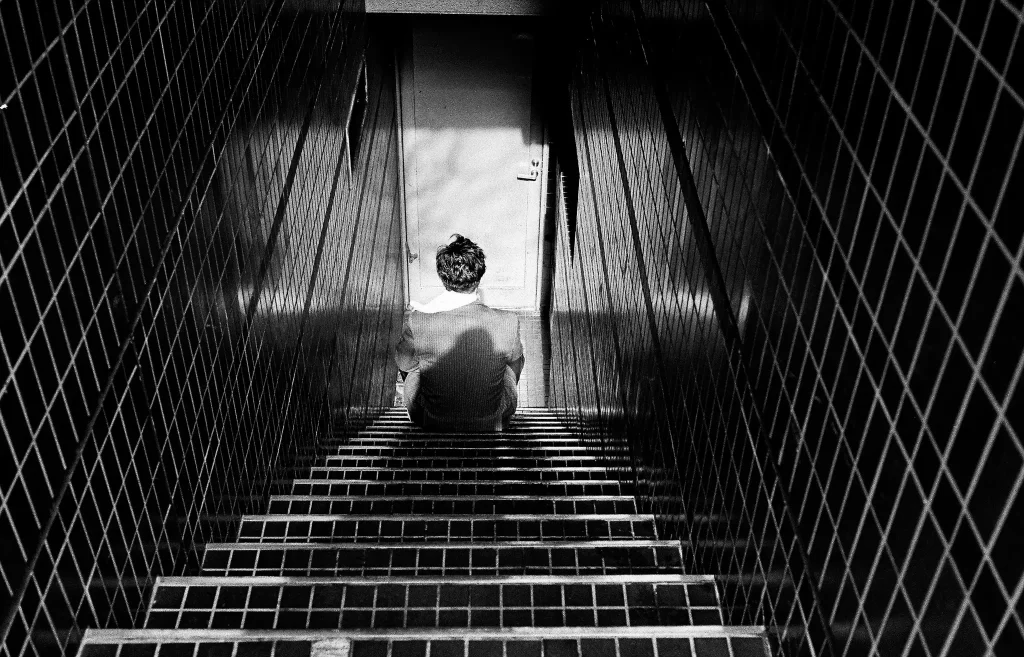
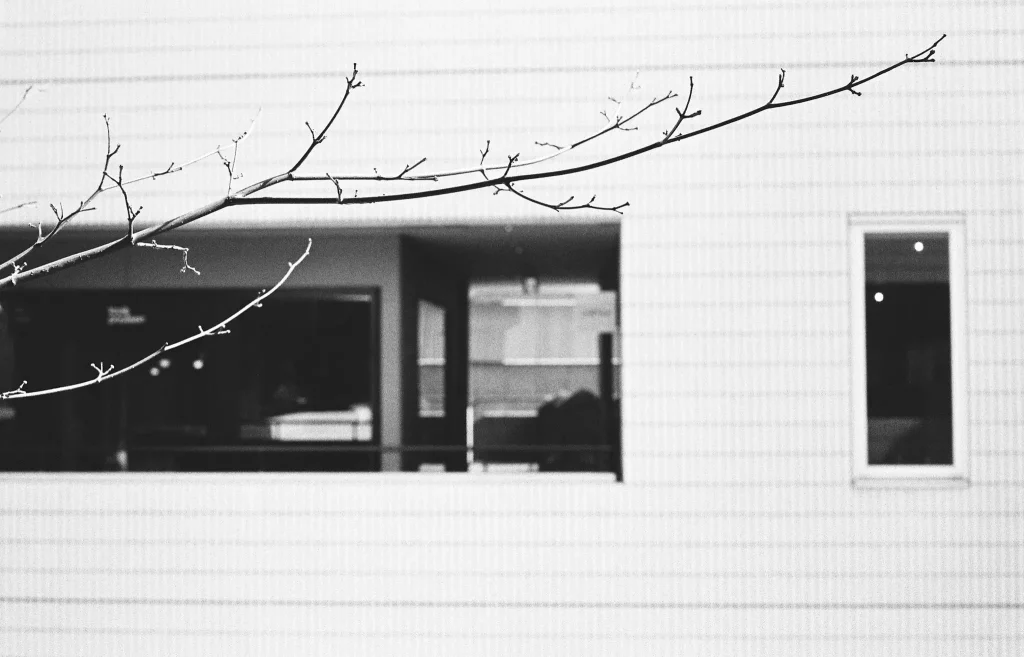
Tokyo in the darkness is just as spectacular as it is in the daytime – maybe even more so. The main parts of town are lit in all kinds of neon and streetlights from every direction. I picked up a roll of 3200 with the intention of shooting it at night, but in the end to try out something different (and often because that is what was loaded from the daytime) I just ended up continuing to shoot 400 speed film in the evenings. This was enjoyable too as it really made you work the photos given the low speed film limitation. Some of the shots below would have been at 1/15 or 1/8 which is still just handhold-able (for a 35mm length) as the camera and lens is well weighted.
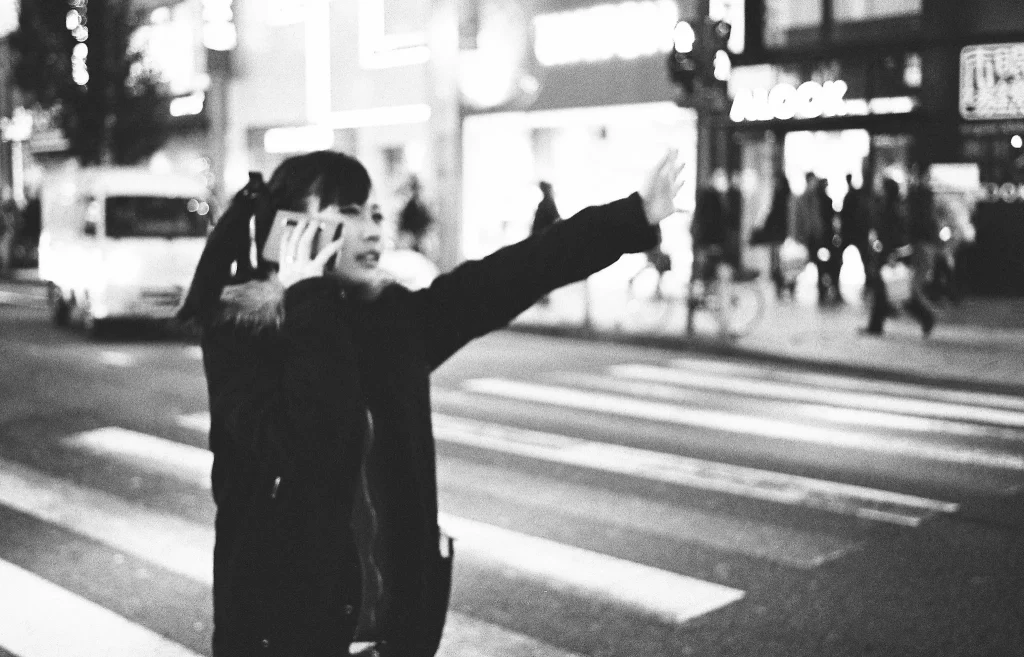
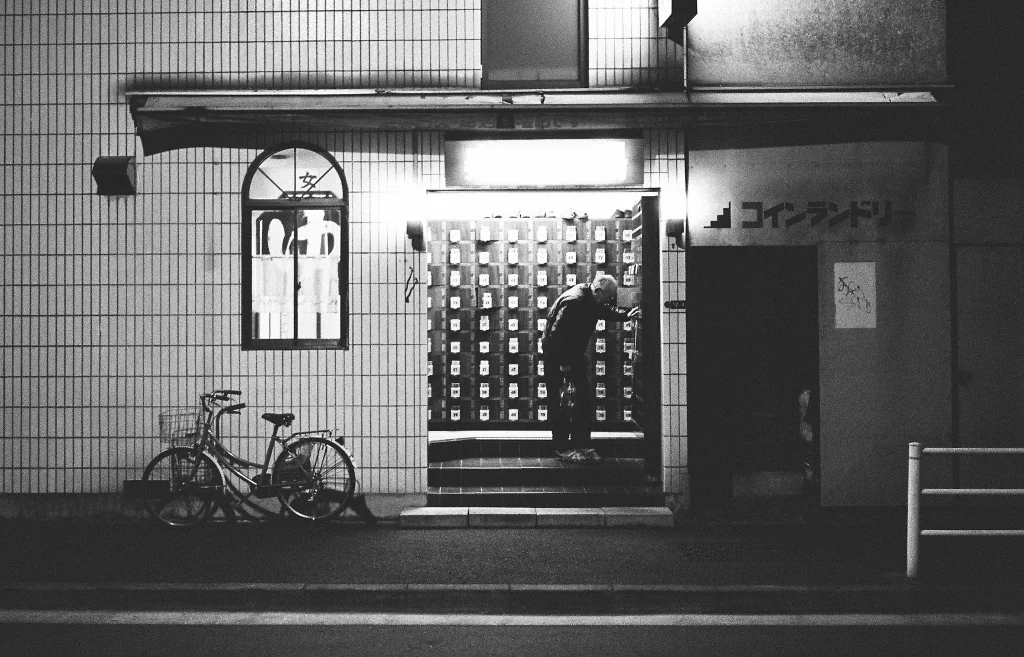
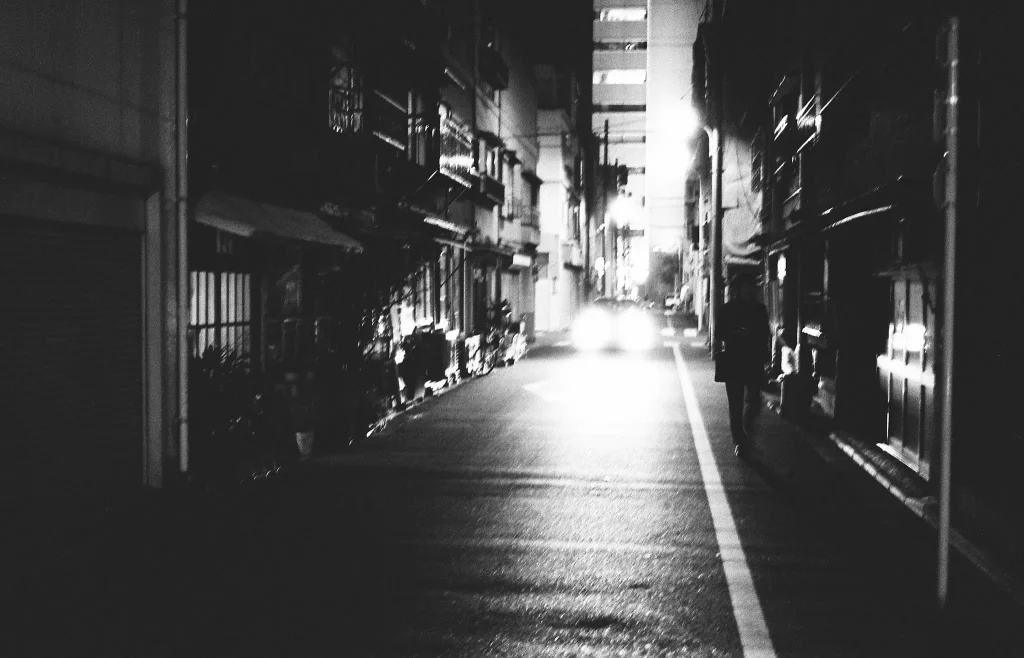
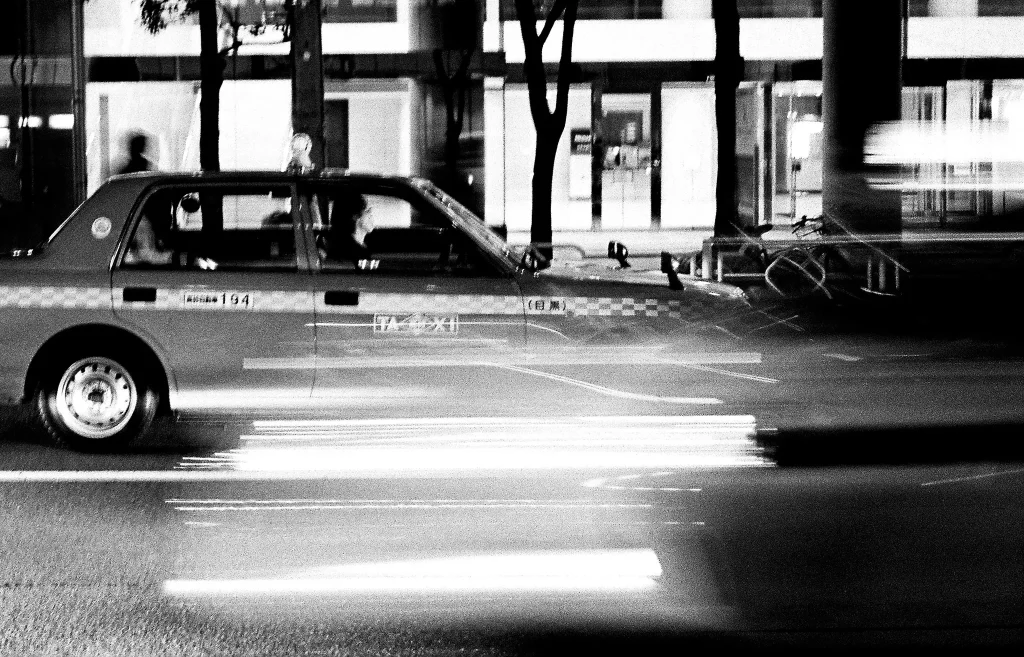
I visited a few camera/film stores during the 5 days that I was there too. Including the famously well-stocked Yodobashi in Shinjuku where I picked up a few rolls. For those that havn’t been to Japan before, Fujiflim is reasonably priced (depending on your currency conversion), while Kodak not so much. Makes sense in terms of where it all comes from, but don’t just expect that because it is one of the biggest film photography centres in the world that everything will be cheap as chips.
Everything in Japan and especially Tokyo is so different to any place you can travel to. So many people, buildings and interesting things to look at. The language barrier is very high – as a traveller it isn’t safe to assume that English is widely spoken (by locals of any age) but with a little wifi router and the connection to the oracle you can pretty much figure out most things. I would recommend a trip to Japan to anyone – just a beautiful place with a great vibe.
Final thoughts
Shooting film again was a joy and I wish that I’d shot more of it when I was there. To begin with, I really enjoyed the limitations that a single fixed lens gave, and also the single speed film loaded – forcing you to be more creative. Even loading the camera was a non-event. I read about people saying this was hard, but it really wasn’t that difficult. The focus on the VC was well damped and had decent resistance to it. Since returning I’ve had a lot more practice with estimating distances and not using the patch at all (both with the M6 and a Rollei 35SE – which is completely zone focus – but that is for another post) . While I was in Tokyo though all of the focusing was done with the camera up to my eye.
In terms of the M6, is it worth the money? Would I recommend it? Well, I can say it truly is a joy to shoot with and feels incredibly well made. Is it worth all the hype? Without a doubt I could have taken most, if not all of the shots here with a much much cheaper setup – there are plenty of other good rangefinders (and compact 35mm) options about – Rollei 35SE i’m looking at you. In the end, for me it really just comes down to choosing gear that you enjoy shooting. If photography is your main thing, and your budget can stretch to it, then I think part of why we shoot is to try things out until we find what fits. These things hold their value very well (and if kept in good nick should increase in value over time) so if you do give one a go and don’t like it – or don’t think it’s worth it, you’ll be able to move it on for around what you paid for it. Or you could get at least two and a half mju ii’s instead…. 😉
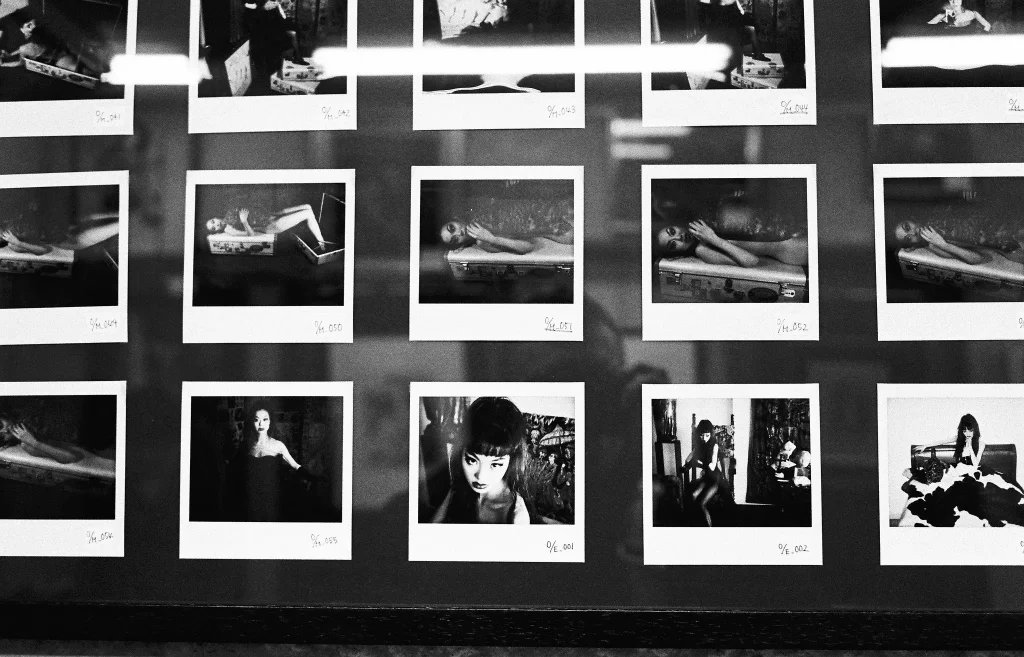
Thanks for reading – if you’ve made it down this far, you deserve a medal.
You can find me at a few different spots linked below. Feel free to follow along, and drop me a note to say g’day.
Portfolio & blog: www.markforbes.com.au
IGs – 35mm film: @_markforbes_ & Assigned work: @markforbesphotographer
Facebook: Mark Forbes – Photography
Documentary weddings – www.onewhiteday.com.au
Limited edition numbered and signed prints of the photos on my website are available to purchase if you’re interested – just contact me for more information.
Thanks, Mark.
Share this post:









Comments
stephenj on Leica M6 Street Photography – Tokyo Files – by Mark Forbes
Comment posted: 08/07/2017
From the top to the bottom, I was glued to this, pictures and text. There is no such thing as fish in a barrel, this is just great work.
I have been through many of the phases that you talk about, sometimes now for the second time, but my work never smells much like any fish that I know of, instead one has to enjoy the occasional morsel. :)
Thank you so much.
Comment posted: 08/07/2017
Dan on Leica M6 Street Photography – Tokyo Files – by Mark Forbes
Comment posted: 08/07/2017
Comment posted: 08/07/2017
Oriol on Leica M6 Street Photography – Tokyo Files – by Mark Forbes
Comment posted: 08/07/2017
Your photos rock, I have enjoyed all of them. I have been to Tokyo three times and I can't wait to come back to shoot with film soon. I just have a question, could you get your film hand checked at Narita airport or did they oblige you to pass it through the X-ray machine? This is the only issue that concerns me about traveling with film these days.. . Many thanks!
Comment posted: 08/07/2017
Chris on Leica M6 Street Photography – Tokyo Files – by Mark Forbes
Comment posted: 08/07/2017
Comment posted: 08/07/2017
jeremy north on Leica M6 Street Photography – Tokyo Files – by Mark Forbes
Comment posted: 09/07/2017
While these pictures could have been as good by using other cameras than a Leica, I found it interesting that it was the experience of shooting with the M6 in particular that facilitated you making the photographs, something which wouldn't have happened had you not been so comfortable with the apparatus.
I too, love the Rollei 35SE so look forward to an article based on your experience with it.
Comment posted: 09/07/2017
Nick on Leica M6 Street Photography – Tokyo Files – by Mark Forbes
Comment posted: 09/07/2017
Comment posted: 09/07/2017
Neil Woodman on Leica M6 Street Photography – Tokyo Files – by Mark Forbes
Comment posted: 09/07/2017
Comment posted: 09/07/2017
Nick on Leica M6 Street Photography – Tokyo Files – by Mark Forbes
Comment posted: 09/07/2017
Comment posted: 09/07/2017
David Luttmann on Leica M6 Street Photography – Tokyo Files – by Mark Forbes
Comment posted: 09/07/2017
Comment posted: 09/07/2017
Victor Bezrukov on Leica M6 Street Photography – Tokyo Files – by Mark Forbes
Comment posted: 09/07/2017
about Leica.. if you want to be the most visible person in Tel Aviv's streets - go with leica. when we walk with my friend (he is with leica and i with 5d mkii) every 5 minutes someone ask him about the camera etc bla-bla no one pay attention to my big DSLR with mostly attached 35m Sigma Art - not too small lens. or maybe my friend just want this attention ?? :-)
Comment posted: 09/07/2017
Paul Hunter on Leica M6 Street Photography – Tokyo Files – by Mark Forbes
Comment posted: 10/07/2017
I actually shot a recent gig with one of the M2's, as the light was so bad that the F6 was struggling to find focus -- manual rangefinder focus worked so much better, and because there was so little light I just set the camera to 1/15 and hoped. Serves me right for covering gigs with film :)
We probably cross paths from time to time in Melbourne -- I'm in or around Hosier Lane most weekends.
Lastly, your portfolio is fantastic -- really strong work. I see that you're not currently using the M6 for your wedding work, but do you think you'd ever consider it?
Cheers
Paul
Comment posted: 10/07/2017
Comment posted: 10/07/2017
Comment posted: 10/07/2017
David McIlroy on Leica M6 Street Photography – Tokyo Files – by Mark Forbes
Comment posted: 11/07/2017
I've owned an M6 Classic and wish I hadn't sold it. I now love using a 1956 M3 SS and I've also just bought a Konica Hexar RF (my 2nd, the 1st being sold). I hope that my preference for discrete Leica shutters will not overcome the much easier on the wallet price of the Hexar when it arrives. Like you, I love the RF shooting experience.
Thanks too hamish for your great blog and for including guest article such as this.
David Comdico on Leica M6 Street Photography – Tokyo Files – by Mark Forbes
Comment posted: 09/08/2017
Mark Forbes on Leica M6 Street Photography – Tokyo Files – by Mark Forbes
Comment posted: 10/08/2017
John Lockwood on Leica M6 Street Photography – Tokyo Files – by Mark Forbes
Comment posted: 22/02/2018
Comment posted: 22/02/2018
NigelH on Leica M6 Street Photography – Tokyo Files – by Mark Forbes
Comment posted: 01/03/2018
Comment posted: 01/03/2018
Etienne Despois on Leica M6 Street Photography – Tokyo Files – by Mark Forbes
Comment posted: 06/03/2018
Comment posted: 06/03/2018
Karl Valentin on Leica M6 Street Photography – Tokyo Files – by Mark Forbes
Comment posted: 10/03/2018
After decades of using Leica gear I sold al the stuff
still think its much overprieced and for a lot of people
just a status symbol
I miss the Leica M3 the most because of its beautiful viewfinder
when you like to shoot with a 50mm lens
So I run into a Nikon S2 by accident and still love to shoot "street"
with it or take it to a trip when I am not up for large equipment
The Nikkor S 1,4/50 is maybe not as sharp as a Summilux but in my
experience the most viewes will not spot it on my pictures
Comment posted: 10/03/2018
Mike Hoeflich on Leica M6 Street Photography – Tokyo Files – by Mark Forbes
Comment posted: 17/12/2018
Comment posted: 17/12/2018
Illya Swan on Leica M6 Street Photography – Tokyo Files – by Mark Forbes
Comment posted: 20/07/2019
Comment posted: 20/07/2019